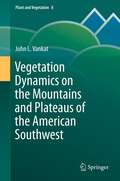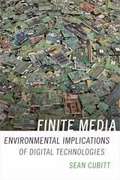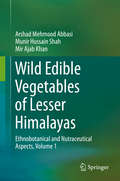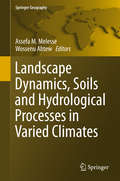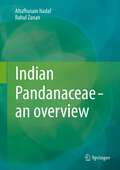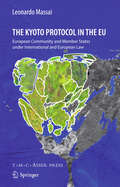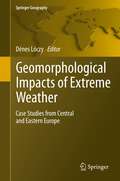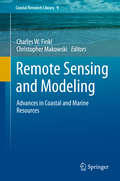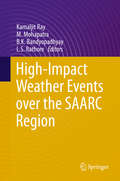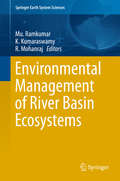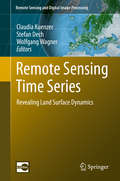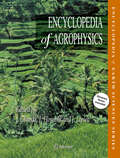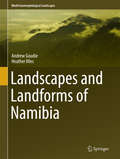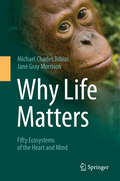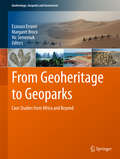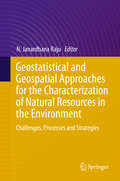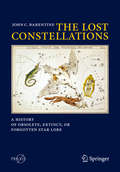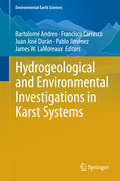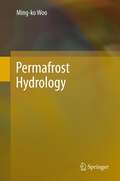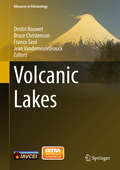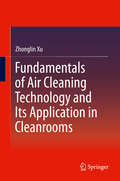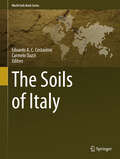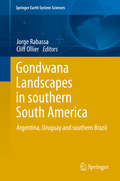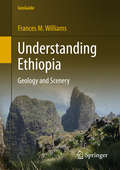- Table View
- List View
Vegetation Dynamics on the Mountains and Plateaus of the American Southwest
by John VankatThe book provides information essential for anyone interested in the ecology of the American Southwest, including land managers, environmental planners, conservationists, ecologists and students. It is unique in its coverage of the hows and whys of dynamics (changes) in the major types of vegetation occurring on southwestern mountains and plateaus. It explains the drivers and processes of change, describes historical changes and provides conceptual models that diagrammatically illustrate past, present, and potential future changes. All major types of vegetation are covered: spruce-fir, mixed conifer, and ponderosa pine forests, pinyon-juniper vegetation, subalpine-montane grassland, and Gambel oak and interior chaparral shrublands. The focus is on vegetation that is relatively undisturbed, i.e., in natural and near-natural condition, and how it responds to natural disturbances such as fire and drought, as well as to anthropogenic disturbances such as fire exclusion and invasive species
Finite Media: Environmental Implications of Digital Technologies
by Sean CubittWhile digital media give us the ability to communicate with and know the world, their use comes at the expense of an immense ecological footprint and environmental degradation. In Finite Media Sean Cubitt offers a large-scale rethinking of theories of mediation by examining the environmental and human toll exacted by mining and the manufacture, use, and disposal of millions of phones, computers, and other devices. The way out is through an eco-political media aesthetics, in which people use media to shift their relationship to the environment and where public goods and spaces are available to all. Cubitt demonstrates this through case studies ranging from the 1906 film The Story of the Kelly Gang to an image of Saturn taken during NASA's Cassini-Huygens mission, suggesting that affective responses to images may generate a populist environmental politics that demands better ways of living and being. Only by reorienting our use of media, Cubitt contends, can we overcome the failures of political elites and the ravages of capital.
Wild Edible Vegetables of Lesser Himalayas
by Arshad Mehmood Abbasi Munir Hussain Shah Mir Ajab KhanOur intention with this book was to present the reader with the most accurate, significant, and up-to-date background and knowledge in the areas of ethnomedicinal and nutraceutical vegetation for the Lesser Himalayas in a comprehensive text. Wild Edible Vegetables of Lesser Himalayas provides a complete review of over 50 important plants of this region and details each species including photographs, botanical name, local name, family, flowering and fruiting period, status and habitat, parts used, distribution, ethnobotanical uses, cultural aspects, medicinal uses, and nutraceutical aspects. Medicinal uses include mode of preparation, method of application and diseases studied; cultural aspects and index; nutraceutical data provides analysis of fats, proteins, fibers, carbohydrates, ash, moisture content, dry matter, and energy value; elemental analysis includes various essential and toxic metals; phytochemical screening includes total phenolics, flavonoids, flavonols and ascorbic acid, and antioxidant potential in terms of DPPH scavenging activity, hydroxyl radical scavenging activity, H2O2 scavenging activity, Fe2+ chelating activity, ferric reducing antioxidant power, and phosphomolybdenum assay for each species. Wild Edible Vegetables of Lesser Himalayas is a concise and handy guide for scientists, scholars, and students interested in the study of agriculture, food science, nutraceutical science, bioscience, biodiversity, applied ethnobotany, ethnoecology, and ecology.
Landscape Dynamics, Soils and Hydrological Processes in Varied Climates
by Assefa M. Melesse Wossenu AbtewThe book presents the processes governing the dynamics of landscapes, soils and sediments, water and energy under different climatic regions using studies conducted in varied climatic zones including arid, semi-arid, humid and wet regions. The spatiotemporal availability of the processes and fluxes and their linkage to the environment, land, soil and water management are presented at various scales. Spatial scales including laboratory, field, watershed, river basin and regions are represented. The effect of tillage operations and land management on soil physical characteristics and soil moisture is discussed. The book has 35 chapters in seven sections: 1) Landscape and Land Cover Dynamics, 2) Rainfall-Runoff Processes, 3) Floods and Hydrological Processes 4) Groundwater Flow and Aquifer Management, 5) Sediment Dynamics and Soil Management, 6) Climate change impact on vegetation, sediment and water dynamics, and 7) Water and Watershed Management.
Indian Pandanaceae - an overview
by Altafhusain Nadaf Rahul ZananIndian screw pine family Pandanaceae represents three genera, in which genus Pandanus and Benstonea are distributed in two hotspots in India - the Western Ghats and the Northeast Himalayan region. For the first time, Indian Pandanaceae has been assessed for its taxonomic status and phylogenetic relationship. The extensive survey by the authors led to the discovery of three new Pandanus species (two from the Western Ghats and one from the Northeast Himalaya). The present taxonomic revision confirmed total number of Pandanus species to 14 that are distributed in the Southern India (9 species) and Northeast Himalayan region (5 species). Genus Benstonea is represented by two species, one from Southern India and another species common to both regions. A detailed species identification key is given along with conservation status of each species following IUCN Red List Categories and Criteria (2001). The study revealed that, out of 16 Pandanus and Benstonea species, six species are under threatened categories. In recent years, a chloroplast DNA-based molecular phylogenetic approach has been followed to understand the evolutionary relationship among the plant species. The interrelationship among the 14 Pandanus species at infrageneric level has been worked out using this approach, which has led to the rearrangement of some species to the subgenera proposed by Stone (1974). Moreover, the close relationship between Pandanus and Benstonea has been confirmed and the interrelationship of Indian Pandanus genus in global context is given. This book also describes the economic importance of each Pandanus species.
The Kyoto Protocol in the EU
by Leonardo MassaiThe participation of the European Community and the Member States in the international climate change regimes is a complex issue. In the case of the Kyoto Protocol, this is rendered more complicated by the fact that, for the purposes of Article 4 of the Kyoto Protocol, the membership of the European Community and Member States is frozen at a particular point in time. The result of this is that, under international law, the European Community and a part of the Member States (EU15) have agreed to jointly fulfil some of those obligations, whereas under community law all Member States share a certain degree of responsibility to meet the obligations created by the Kyoto Protocol. This book analyses in great detail the Kyoto Protocol and the obligations established, such as monitoring and reporting obligations, eligibility criteria and reduction commitments.
Geomorphological impacts of extreme weather
by Denes LoczyThis book presents new research on the geomorphological impacts of extreme precipitation events. It focuses on the extreme summer floods, which affected Central and Eastern Europe in 2010. Case studies on their consequences, including inundations, urban flooding, soil erosion, river bank retreat, alluvial fan accumulation, evolution of karst depressions, debris flows, landslides and soil saturation are presented for Poland, the Czech Republic, Ukraine, Slovakia, Hungary, Romania, Slovenia, Croatia, Serbia, Bulgaria and Macedonia. This key applied geomorphology book is crucial for anyone interested in these processes and their consequences and also for decision makers who face these catastrophes.
Remote Sensing and Modeling
by Charles W. Finkl Christopher MakowskiThis book is geared for advanced level research in the general subject area of remote sensing and modeling as they apply to the coastal marine environment. The various chapters focus on the latest scientific and technical advances in the service of better understanding coastal marine environments for their care, conservation and management. Chapters specifically deal with advances in remote sensing coastal classifications, environmental monitoring, digital ocean technological advances, geophysical methods, geoacoustics, X-band radar, risk assessment models, GIS applications, real-time modeling systems, and spatial modeling. Readers will find this book useful because it summarizes applications of new research methods in one of the world's most dynamic and complicated environments. Chapters in this book will be of interest to specialists in the coastal marine environment who deals with aspects of environmental monitoring and assessment via remote sensing techniques and numerical modeling.
High-Impact Weather Events over the SAARC Region
by Kamaljit Ray M. Mohapatra B. K. Bandyopadhyay L. S. RathoreThis book is a compilation of papers contributed by researchers and scientists from SAARC nations and deals with high-impact weather conditions, their prediction and potential consequences for populations in the SAARC region. There have been a number of recent advances in our understanding and prediction of cyclones, severe thunderstorms, squalls, heat and cold waves, droughts and heavy rainfall, based on the latest observational data and NWP modeling platform. The SAARC region is vulnerable to high-impact weather events because of geophysical features like high mountains, plateaus and vast oceans. As our climate continues to change over the coming years, the likelihood of extreme and potentially high-impact weather and climate events will be at its highest when natural and anthropogenic effects combine. All chapters were written by leading experts in their respective research and operational fields. The book reviews the latest research, future needs, forecasting skills and societal impacts of extreme weather events and offers high-quality reference material for weather forecasters, disaster managers and researchers.
Environmental Management of River Basin Ecosystems
by Mu. Ramkumar K. Kumaraswamy R. MohanrajThis book offers a unique collection of inter- and multidisciplinary studies on river systems. Rivers have been the prime source of sustenance since the advent of civilization and river systems often form the basis for agriculture, transport, water, and land for domestic, commercial, and industrial activities, fostering economic prosperity. A river basin is a basic geographical and climatological unit within which the vagaries of natural processes act and manifest themselves at different spatio-temporal scales. Even if compared side-by-side, no two river basins respond to natural processes in the same way and thus, it has long been recognized that each river basin is unique. Hence, any developmental activity or conservation effort has to be designed and implemented to match each unique river basin. With the burgeoning population and increasing dependency on natural resources, understanding and maintaining river systems has become increasingly important. This book provides a varied reference work on and unprecedented guidelines for conducting and implementing research on river basins, and for managing their ecological development.
Remote Sensing Time Series
by Claudia Kuenzer Stefan Dech Wolfgang WagnerThis volume comprises an outstanding variety of chapters on Earth Observation based time series analyses, undertaken to reveal past and current land surface dynamics for large areas. What exactly are time series of Earth Observation data? Which sensors are available to generate real time series? How can they be processed to reveal their valuable hidden information? Which challenges are encountered on the way and which pre-processing is needed? And last but not least: which processes can be observed? How are large regions of our planet changing over time and which dynamics and trends are visible? These and many other questions are answered within this book "Remote Sensing Time Series Analyses - Revealing Land Surface Dynamics". Internationally renowned experts from Europe, the USA and China present their exciting findings based on the exploitation of satellite data archives from well-known sensors such as AVHRR, MODIS, Landsat, ENVISAT, ERS and METOP amongst others. Selected review and methods chapters provide a good overview over time series processing and the recent advances in the optical and radar domain. A fine selection of application chapters addresses multi-class land cover and land use change at national to continental scale, the derivation of patterns of vegetation phenology, biomass assessments, investigations on snow cover duration and recent dynamics, as well as urban sprawl observed over time.
Encyclopedia of Agrophysics
by Charles W. Finkl Eugene V. Shein Jan Gliński Jerzy Lipiec Josse De Baerdemaeker Józef Horabik Krystyna Konstankiewicz Rainer Horn Stanislaw Grundas Winfried E. Blum Yakov PachepskyThis Encyclopedia of Agrophysics will provide up-to-date information on the physical properties and processes affecting the quality of the environment and plant production. It will be a "first-up" volume which will nicely complement the recently published Encyclopedia of Soil Science, (November 2007) which was published in the same series. In a single authoritative volume a collection of about 250 informative articles and ca 400 glossary terms covering all aspects of agrophysics will be presented. The authors will be renowned specialists in various aspects in agrophysics from a wide variety of countries. Agrophysics is important both for research and practical use not only in agriculture, but also in areas like environmental science, land reclamation, food processing etc. Agrophysics is a relatively new interdisciplinary field closely related to Agrochemistry, Agrobiology, Agroclimatology and Agroecology. Nowadays it has been fully accepted as an agricultural and environmental discipline. As such this Encyclopedia volume will be an indispensable working tool for scientists and practitioners from different disciplines, like agriculture, soil science, geosciences, environmental science, geography, and engineering.
Landscapes and Landforms of Namibia
by Andrew Goudie Heather VilesThe landscapes of Namibia are of world-class quality in beauty, diversity and interest. This book provides the first ever overview of the most important of these landscapes, explains why they look as they do, and evaluates why they are of note. Writing from a geomorphological perspective, the authors introduce the key processes and controls which influence landscape and landform development in Namibia. Geological and tectonic background, climate now and in the past, vegetation and animals (including humans) are all identified as crucial factors influencing the landscape of Namibia today. The book presents twenty one richly-illustrated case studies of the most significant landscapes of Namibia, ranging from the iconic Etosha Pan at the heart of the biggest wildlife conservation area in the north, to the famous dunes and ephemeral river at Sossus Vlei in the heart of the Namib desert. Each case study also contains a full list of the key references to the scientific work on that landscape. The authors provide an assessment of the current state of conservation of these landscapes, and their importance to tourism. The book is recommended reading for anyone with a professional or amateur interest in the spectacular and intriguing landscapes of this part of southern Africa. It provides a useful handbook for those travelling around Namibia, and an invaluable reference guide for those interested in how landscapes develop and change.
Why Life Matters
by Michael Charles Tobias Jane Gray MorrisonDr. Michael Charles Tobias and Jane Gray Morrison are world-renowned ecological philosophers and activists, interdisciplinary social and environmental scientists and broad-ranging, deeply committed humanists. This collection of fifty essays and interviews comprises an invigorating, outspoken, provocative and eloquent overview of the ecological humanities in one highly accessible volume. The components of this collection were published in the authors' "Green Conversations" blog series, and pieces in the Eco News Network from 2011 to 2013 and feature luminaries from Jane Goodall to Ted Turner to the Secretary of the Smithsonian Institution to the former head of the UN Convention on Biological Diversity. Stunning color photographs captured by the authors and contributors make Why Life Matters: Fifty Ecosystems of the Heart and Mind a feast for the eyes as well as the mind and soul. Ethics, science, technology, ecological literacy, grass-roots renaissance thinkers, conservation innovation from the U. S. to the U. K. ; from India to Ecuador; from Bhutan to Haiti; from across Africa, the Neo-Tropics, Central Asia and Japan, to Rio, Shanghai and Manhattan - this humanistic ode to the future of life on earth is a relevant and resonating read. Michael Tobias and Jane Gray Morrison, partners who between them have authored some 50 books and written, directed and produced some 170 films, a prolific body of work that has been read, translated and/or broadcast around the world, have been married for more than a quarter-of-a-century. Their field research across the disciplines of comparative literature, anthropology, the history of science and philosophy, ecology and ethics, in over 80 countries, has served as a telling example of what two people - deeply in love with one another - can accomplish in spreading that same unconditional love to others - of all species.
From Geoheritage to Geoparks
by Ezzoura Errami Margaret Brocx Vic SemeniukThis unique book is dedicated to helping promote geoheritage, geoconservation, and geoparks in Africa and the Middle East. Local, regional, global and thematic case studies including a geoheritage toolkit are used to illustrate the scope and depth of geoheritage and highlight some current geoparks and aspiring candidates in Africa, the Middle East, China , Europe,and Australia. This special issue mainly consists of the proceedings of the First International Conference on Geoparks in Africa and Middle East (FICGAME) held in, El Jadida, Morocco in 2011. The conference, hosted by the Faculty of Sciences of Chouaib Doukkali University, was organized by the African Geoparks Network and the African Association of Women in Geosciences incollaboration with the UNESCO Cairo Office.
Geostatistical and Geospatial Approaches for the Characterization of Natural Resources in the Environment
by N. Janardhana RajuThese proceedings of the IAMG 2014 conference in New Delhi explore the current state of the art and inform readers about the latest geostatistical and space-based technologies for assessment and management in the contexts of natural resource exploration, environmental pollution, hazards and natural disaster research. The proceedings cover 3D visualization, time-series analysis, environmental geochemistry, numerical solutions in hydrology and hydrogeology, geotechnical engineering, multivariate geostatistics, disaster management, fractal modeling, petroleum exploration, geoinformatics, sedimentary basin analysis, spatiotemporal modeling, digital rock geophysics, advanced mining assessment and glacial studies, and range from the laboratory to integrated field studies. Mathematics plays a key part in the crust, mantle, oceans and atmosphere, creating climates that cause natural disasters, and influencing fundamental aspects of life-supporting systems and many other geological processes affecting Planet Earth. As such, it is essential to understand the synergy between the classical geosciences and mathematics, which can provide the methodological tools needed to tackle complex problems in modern geosciences. The development of science and technology, transforming from a descriptive stage to a more quantitative stage, involves qualitative interpretations such as conceptual models that are complemented by quantification, e. g. numerical models, fast dynamic geologic models, deterministic and stochastic models. Due to the increasing complexity of the problems faced by today's geoscientists, joint efforts to establish new conceptual and numerical models and develop new paradigms are called for.
The Lost Constellations
by John C. BarentineCasual stargazers are familiar with many classical figures and asterisms composed of bright stars (e. g. , Orion and the Plough), but this book reveals not just the constellations of today but those of yesteryear. The history of the human identification of constellations among the stars is explored through the stories of some influential celestial cartographers whose works determined whether new inventions survived. The history of how the modern set of 88 constellations was defined by the professional astronomy community is recounted, explaining how the constellations described in the book became permanently "extinct. " Dr. Barentine addresses why some figures were tried and discarded, and also directs observers to how those figures can still be picked out on a clear night if one knows where to look. These lost constellations are described in great detail using historical references, enabling observers to rediscover them on their own surveys of the sky. Treatment of the obsolete constellations as extant features of the night sky adds a new dimension to stargazing that merges history with the accessibility and immediacy of the night sky.
Hydrogeological and Environmental Investigations in Karst Systems
by Bartolomé Andreo Francisco Carrasco Juan José Durán Pablo Jiménez James W. LamoreauxWATER RESOURCES AND ENVIRONMENT provides a detailed introduction to the full range of advanced, multidisciplinary techniques used in the study of water resources from understanding individual aquifers to the protection and management of water in a sustainable way, compatible with the preservation of the environment. Based on a masters course from UNESCO's International Hydrological Program, this textbook is accompanied by color figures and graphics, illustrating clearly the content of the text and showing real examples from the field. Each chapter also contains a list of exercises and practical activities as well as case studies.
Heidi
by BPI India Pvt LtdIt is a Story about the events in the life of a young girl under the care of her grandfather
Permafrost Hydrology
by Ming-Ko WooPermafrost Hydrology systematically elucidates the roles of seasonally and perennially frozen ground on the distribution, storage and flow of water. Cold regions of the World are subject to mounting development which significantly affects the physical environment. Climate change, natural or human-induced, reinforces the impacts. Knowledge of surface and ground water processes operating in permafrost terrain is fundamental to planning, management and conservation. This book is an indispensable reference for libraries and researchers, an information source for practitioners, and a valuable text for training the next generations of cold region scientists and engineers.
Volcanic Lakes
by Dmitri Rouwet Bruce Christenson Franco Tassi Jean VandemeulebrouckThis book aims to give an overview on the present state of volcanic lake research, covering topics such as volcano monitoring, the chemistry, dynamics and degassing of acidic crater lakes, mass-energy-chemical-isotopic balance approaches, limnology and degassing of Nyos-type lakes, the impact on the human and natural environment, the eruption products and impact of crater lake breaching eruptions, numerical modeling of gas clouds and lake eruptions, thermo-hydro-mechanical and deformation modeling, CO2 fluxes from lakes, volcanic lakes observed from space, biological activity, continuous monitoring techniques, and some aspects more. We hope to offer an updated manual on volcanic lake research, providing classic research methods, and point towards a more high-tech approach of future volcanic lake research and continuous monitoring.
Fundamentals of Air Cleaning Technology and Its Application in Cleanrooms
by Zhonglin XuFundamentals of Air Cleaning Technology and Its Application in Cleanrooms sets up the theoretical framework for cleanrooms. New ideas and methods are presented, which include the characteristic index of cleanrooms, uniform and non-uniform distribution characteristics, the minimum sampling volume, a new concept of outdoor air conditioning and the fundamentals of leakage-preventing layers. Written by an author who can look back on major scientific achievements and 50 years of experience in this field, this book offers a concise and accessible introduction to the fundamentals of air cleaning technology and its application. The work is intended for researchers, college teachers, graduates, designers, technicians and corporate R&D personnel in the field of HVAC and air cleaning technology. Zhonglin Xu is a senior research fellow at China Academy of Building Research.
The Soils of Italy
by Carmelo Dazzi Edoardo A.C. CostantiniThe Soils of Italy is the first comprehensive book on Italian pedology in seventy years. Taking advantage of the authors' large experience and of the most up-to-date information and technology, this book treats the main soil types of Italy, their diffusion, their functions, ecological use, and the threats to which they are subjected during centuries of intensive management. It also deals with future scenarios of the relationships between soil science and other disciplines, such as urban development, medicine, economics, sociology, and archaeology. The description of the soils is accompanied by a complete set of data, pictures and maps, including benchmark profiles. Factors of soil formation are also treated, making use of new, unpublished data and elaborations. The book also includes a history of pedological research in Italy, spanning over a century.
Gondwana Landscapes in southern South America
by Jorge Rabassa Cliff OllierThis book presents extensive and new information on the geomorphology of cratonic areas of southern South America. It includes valuable data relating to recurrent controversies in general geomorphology beyond the boundaries of South America and reveals the great need to integrate many different aspects of geomorphology in regional studies. With the focus on ancient landscapes and especially on planation surfaces it addresses the question of what processes could form such huge features, and how they can be preserved for so long. Many of the papers include maps of planation surfaces or other geomorphic units. The volume brings together an up-to-date, state-of-the-art collection of information on South American geomorphology, and shows beyond doubt that geomorphology is on the same time scale as global tectonics, biological evolution and major climate change. Some of the papers describe ancient geomorphological features of areas that have never been studied or published before, while others describe regions which are totally unknown to the public. The scope of the book extends from tropical latitudes north of the Tropic of Capricorn, south to freezing Patagonia in the "roaring fifties", more than 3,500 km from north to south. Including over one thousand citations from geological and geomorphological literature, this volume will serve as a starting point for a whole new phase of studies of the fascinating landscape history of southern South America.
Understanding Ethiopia
by Frances M. WilliamsUnderstanding Ethiopia is a detailed description of Ethiopia's geological story and enables non-specialist readers to share the author's thrill at gaining a deeper insight into the processes which produced, and continue to shape, this amazing country. Ethiopia's spectacular landscapes, ranging from mountains over 4500m high to salt plains 150m below sea level, are a reflection of the geological processes that formed the country. Indeed, its history and the historical sites, for which it is renowned, are largely determined by geology. Readers learn why and how Ethiopia's geology is both unique and dynamic, as here the earth's crust is in the process of breaking apart.
